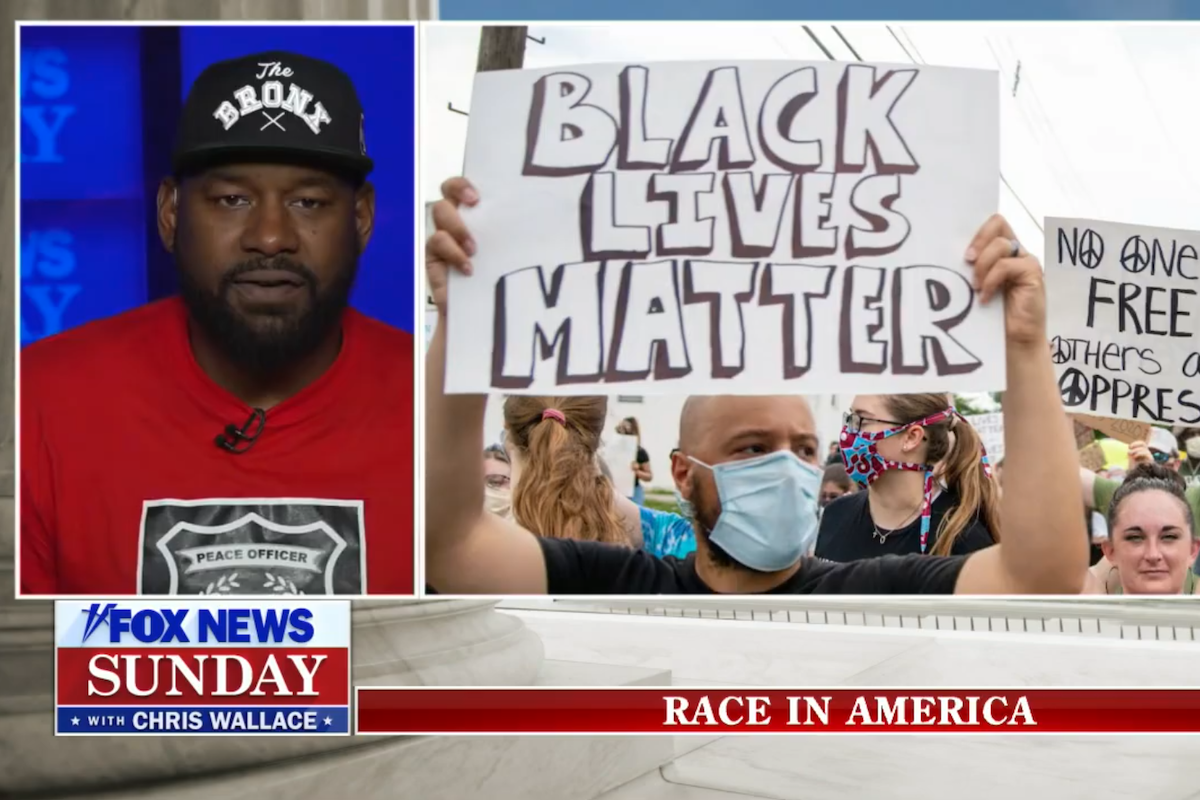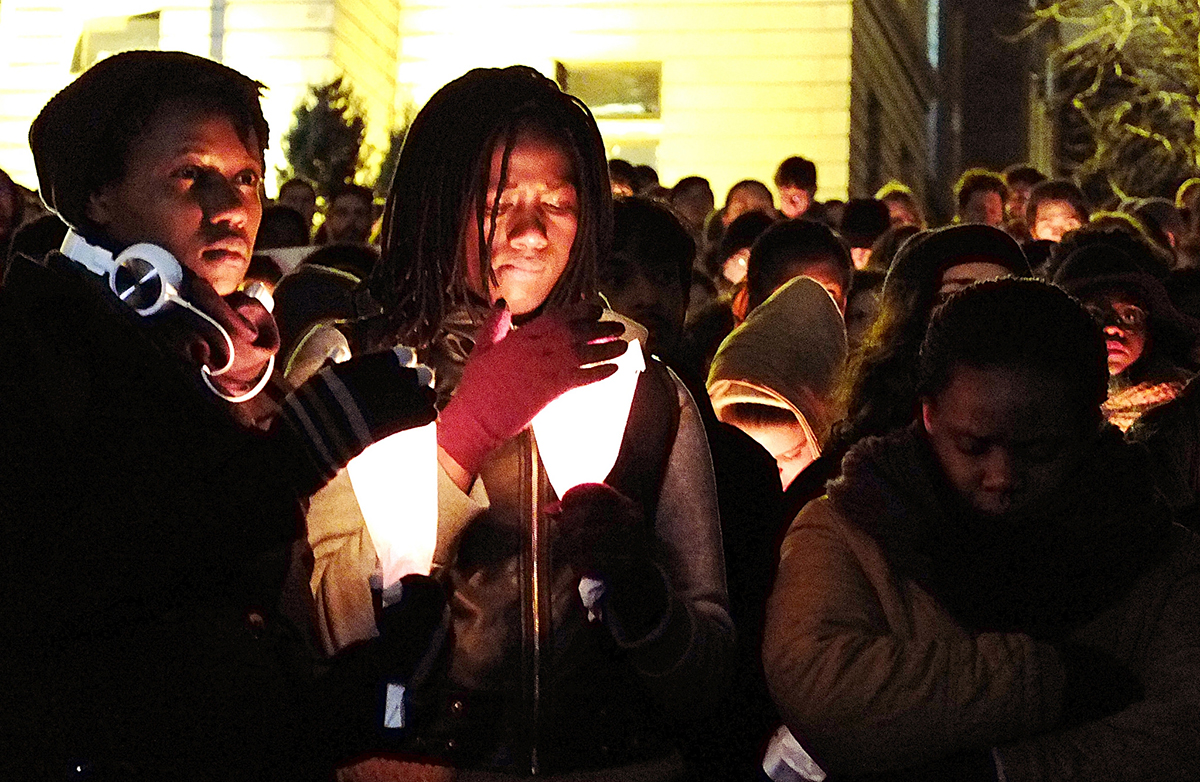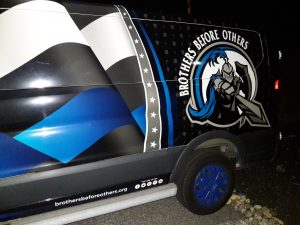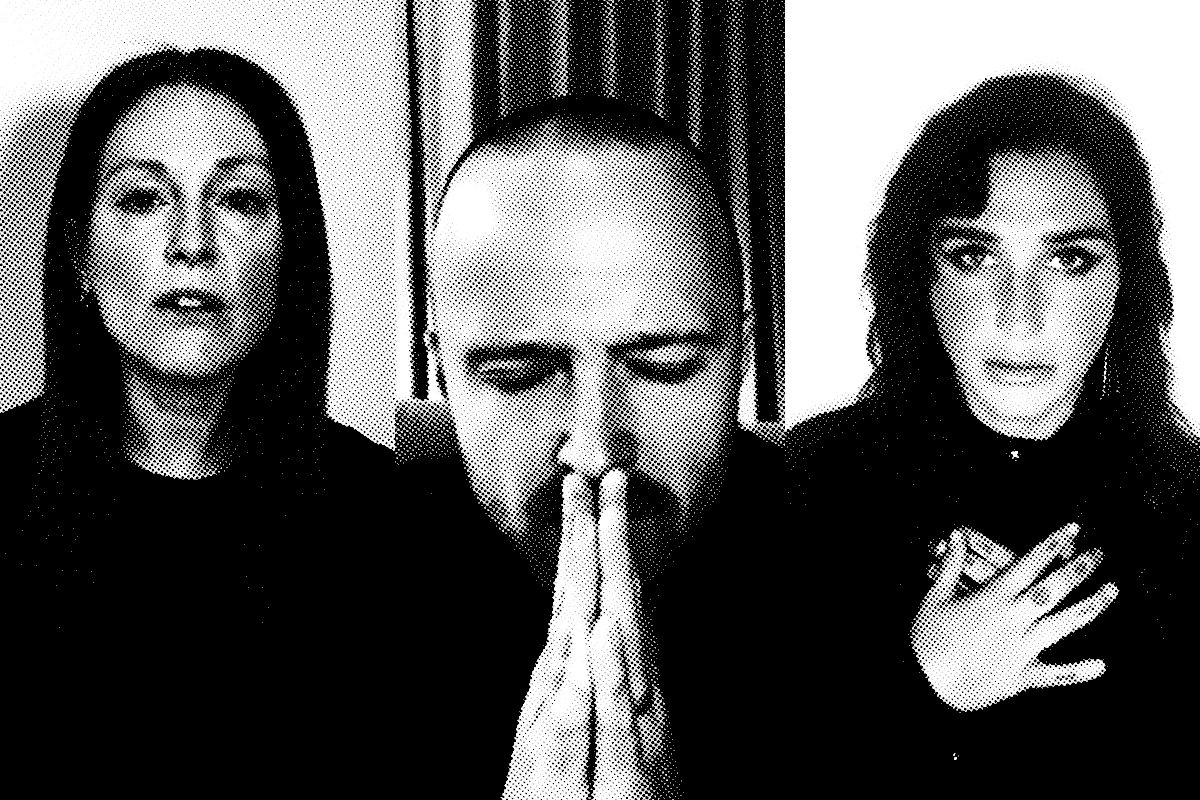Activism
Who Speaks for Black Lives Matter? The Answer Can Be Complicated
As one might imagine, it generally is opposed by many Black Lives Matter supporters, as they disagree with any implied parallel between racist treatment of blacks and the occupational hazards of police work.

On October 2nd, the New York Times ran a profile of Hawk Newsome, the Bronx-based co-founder of Black Lives Matter of Greater New York. “At over 6 feet tall and 300 pounds, often wearing a bulletproof vest beneath his shirt and puffing on a Padron 1964 Anniversary Series cigar, Hawk Newsome is hard to miss,” wrote reporter Derek M. Norman. “When [he] is not speaking with the news media or organizing events, Mr. Newsome, 43, can be found at marches from Charlottesville, Va., to Minneapolis to New York City. ‘The first thing I do is open up my Bible to see what the scripture of the day is,’ Newsome told the Times. ‘If there’s anything I want back more than anything from before, it’s church. Every Sunday I’d go, twice.’” Aside from wearing a bulletproof vest, Newsome also rents multiple cars, so he can “switch them up because it’s safer and nobody could keep track of what I’m driving.” He also told the Times that when he attends protest events, “Usually, I’ll have one or two people assigned to my personal security.”
Two weeks before the Times ran Newsome’s profile, he and his sister Chivona—also a local Black Lives Matter co-founder—had been scheduled to speak as part of The Mill Series at Lafayette College, founded by professor of government and law Brandon Van Dyck as a means to promote viewpoint diversity at the Easton, Pennsylvania-based school. Since 2017, Van Dyck and student assistants have moderated discussions on a wide array of topics—race, gender, Donald Trump, anti-Semitism, the war in Iraq—featuring prominent and sometimes controversial public intellectuals such as Jordan Peterson, Camille Paglia, Coleman Hughes, the late Michael Brooks, Jonathan Haidt, Jeffrey Sachs, and Matt Stoller. The series functions for the benefit of the college community, but is funded independently. Speakers are paid an honorarium and compensated for travel and lodging expenses.
I’ve written appreciatively about the The Mill Series in the past. And when I learned that Black Lives Matter (BLM) leaders were taking part in an upcoming event, I was eager to attend. BLM has been around in some form since 2012. And its opposition to police violence against blacks has earned approval among most Americans. But its ideological contours remain somewhat obscure. Co-founder Patrisse Cullors says that her approach to activism is informed by Marx, Lenin, Mao, and “all types of global critical theory”—texts that Cullors describes as providing “a new understanding around what our economies could look like.” As well as describing herself as a “trained Marxist,” she is also a supporter of the Boycott, Divestment and Sanctions campaign against Israel, which is criticized by many as anti-Semitic. A common BLM demand is the complete abolition of police forces. And until last month, BLM’s national website encouraged followers to “disrupt the Western-prescribed nuclear family structure requirement by supporting each other as extended families and “villages” that collectively care for one another, especially our children, to the degree that mothers, parents, and children are comfortable.”
I was happy to make the hour-and-a-half drive from Brooklyn to Easton, because I wanted to see how these two Black Lives Matter activists and committed Christians would answer questions about such radical postures. I also wanted to ask about local issues—including the massive surge in homicides that New York and other large cities have witnessed since the public campaign against police reached its crescendo in late May and June. Did all black lives matter, I intended to ask the Newsomes—or only those taken by the police? These are awkward questions to ask. But the Newsomes have been known to engage with critics in public fora. Chivona recently ran for Congress. Hawk has debated conservative author Candace Owens, and even made a case for Black Lives Matter on stage at a pro-Trump rally.
The Newsomes’s September 24th Mill Series appearance was supposed to be held on campus and conducted according to the standard format: a discussion or presentation, followed by a Q&A lasting as long as the speakers were willing to stay, all open to the public, with the full proceedings recorded for YouTube. But due to pandemic concerns, attendance for the Newsomes was capped at a dozen people, with those few seats allotted weeks in advance. Van Dyck told me that many people asked to attend, but that he’d assigned priority to Lafayette students.

However, on September 22nd, two days before his scheduled appearance, Hawk Newsome contacted Van Dyck with concerns about security on campus. “I called public safety immediately, asking if they could post a couple of officers,” Van Dyck told me. “Public safety contacted administration, and I was informed the event could not go forward on Lafayette premises [due to the health crisis].”
So Van Dyck turned to Dorian Vallejo and his girlfriend Kelly Houghton, a pair of local artists who agreed to host the event in their combined studio and art school, located in the nearby town of Phillipsburg, NJ, just across the river from Lafayette College. On short notice, the couple prepared one of their classrooms with appropriate seating, lighting, cameras, and audio equipment. Just before the event, I met up with Van Dyck on Lafayette campus, along with 10 of his students, the Newsomes, and a third New York-area BLM activist named Linda Cherry. Everyone was masked as we piled into Van Dyck’s and Vallejo’s cars for the short drive to Phillipsburg, with the Newsomes following in an SUV.
Five minutes later, we arrived at a squat U-shaped building perched between Main Street and the Phillipsburg Middle School. The small parking lot was empty except for a pair of vans. While the Newsomes and Cherry were waiting to be wired with microphones, students were directed into one of the classrooms, where art supplies had been neatly stowed away in plastic bins. It was much smaller than Lafayette’s lecture halls, but easily sufficient to accommodate this small crowd.
That was when Van Dyke and Vallejo were summoned by the videographer. Something was wrong. A cordial but strained exchange between Van Dyck and the BLM activists was followed by awkward handshaking. Then, as the students watched, all three activists walked out, got in their Chevy Suburban and left without a word or gesture to the people who’d come to see them speak.
Van Dyck, seeming slightly at a loss, took a seat next to Vallejo and faced his students. “I’m not sure how many of you heard that,” he said. “What just happened is, they saw a truck that said Blue Lives Matter—is that right?—with American flags. They don’t know me at all. They weren’t rude about it, but what Hawk said was, ‘I don’t know you. I can’t really trust you. I don’t know where we are right now. It’s a crazy time and we have to be safe, and so we’ve got to split.’”
“They felt unsafe,” Van Dyck, stunned and contrite, kept saying. “They felt unsafe and I wasn’t able to convince them that they were safe… I am sorry, everyone… Does anyone have any thoughts about what happened?” What followed was a two-hour conversation among Van Dyck, Vallejo, and the students—a group that seemed about evenly divided between white and non-white attendees.

is a group of police officers, former police officers, and supporters who seek more severe punishment for criminals who attack law-enforcement workers. As one might imagine, it generally is opposed by many Black Lives Matter supporters, as they disagree with any implied parallel between racist treatment of blacks and the occupational hazards of police work. But when we checked out the parking lot, it became clear that the two flag-painted vans (see photos) parked outside actually were operated by Brothers Before Others, a not-for-profit 501(c)(3) charity founded in 2014 by 9/11 first responder Michael Burke “to provide a floral arrangement (via the National Flower Fund) to every officer’s department and family, ensuring that no Line of Duty Death would go unnoticed.” Though its operations have expanded over time, the group’s apolitical mandate is confined to supporting the families of fallen police officers, regardless of race.

“In a word, I’m sad,” said Burke when I told him what had happened. “I wish I was there to meet them. I’d tell them how during the worst of COVID, our volunteers, all cops, gave out masks and hand sanitizer, mostly to poor and minority communities. How we do Christmas drives and no kid ever goes home without a toy. That in 2020 a flag can get that kind of reaction—it just makes me sad.”
The next morning, Van Dyck received a message from Hawk Newsome, who now seemed less cordial. “Imagine asking a Jewish person to speak at a place with a swastika painted on it,” Newsome wrote. Also, “we would appreciate being compensated for our time.”
Of course, Newsome is hardly crazy to imagine that he might be assaulted when he appears at public events—though a small gathering at an arts school, the location of which was announced to participants only minutes before they were taken there, doesn’t seem like a high-risk activity. And it’s also easy to understand how he confused Brothers Before Others with Blue Lives Matter (though it should be said that neither group is violent). But the story took a weird turn when I began looking into Newsome’s back story. It turns out that on June 25th, 2020, the Black Lives Matter Global Network Foundation (BLM Global)—the national, organizing chapter of many local Black Lives Matter chapters—had disavowed Newsome’s claim to leadership of BLM’s New York chapter, something that Norman didn’t mention in his Times article about Newsome. The Foundation’s press release read as follows:
Today, Donald Trump attributed a quote to a “Black Lives Matter leader” on his social media. We have traced these comments to Hawk Newsome. Hawk Newsome has no relation to the Black Lives Matter Global Network (“BLM”) founded by Patrisse Cullors, Alicia Garza, and Opal Tometi—and is not the “president” of BLM or any of its chapters. Only BLM chapters [that] adhere to BLM’s principles and code of ethics are permitted to use the BLM name. The reason for this is simple: Unaffiliated uses of BLM’s name are confusing to people who may wrongly associate the unsanctioned group and its views and actions with BLM. As BLM has told Mr. Newsome in the past, and as is still true today, Mr. Newsome’s group is not a chapter of BLM, and has not entered into any agreement with BLM agreeing to adhere to BLM’s core principles. The only official chapter of BLM in New York is Black Lives Matter NYC. BLM Global Network strongly encourages anyone interested in learning about or becoming a part of our movement to seek information from trusted, official sources—such as our BLM Global Network social feeds (@blklivesmatter), our emails, and our official Black Lives Matters website (blacklivesmatter.com)—rather than unknown or untrusted sources using BLM’s name.
On the surface, this might seem a case of a national umbrella organization distancing itself from a radicalized local activist. But from what I can tell, it’s the opposite. Despite his fiery rhetoric, Newsome and his BLM group (or BLM imitator, depending on whom you believe) espouses a sharp-edged version of traditional black-liberation ideology rooted in civil rights. BLM Global, by contrast, seems to be more explicitly Marxist and revolutionary. Presumably, BLM Global didn’t approve of Newsome appearing at a Trump event, nor of his appearance on FOX News (which is where he’d made the comments that Trump had tweeted out).
Raised in the Bronx, Newsome dropped out of high school, but found his way back to college, and later worked as a paralegal for the Bronx District Attorney County Office. He eventually got a law degree and ran, unsuccessfully, for New York City Council. After attending Howard University, his younger sister Chivona, 36, went on to serve on the 2008 Presidential Inaugural Committee of then Senator Barack Obama. Both became active in Black Lives Matter after the killing of Trayvon Martin in 2012.

BLM didn’t respond to my request for comment. Neither did the Newsomes. But in an interview with Forbes, Chivona acknowledged that by the time they’d founded their New York organization, “there already was a Black Lives Matter chapter in New York that tried to end systemic oppression through the arts.” As the Forbes article reported, “she and her brother wanted to take more direct action with strong push for changes in legislation. They also decided not to affiliate with the Black Lives Matter Global Network.”
“We don’t believe anyone should have ownership over the term Black Lives Matter,” she told Forbes. “It is a movement.”
“We are not anti-cop, we’re anti-bad cop,” Hawk told CNN’s Carol Costello after he famously spoke at that Washington D.C. pro-Trump rally in September 2017. “Black Lives Matter of Greater New York is not part of the network. You have people who are part of the official network who are like ‘No, you shouldn’t have spoken to Trump supporters. You’re not part of our network. How dare you speak on our behalf.’ We just move in a different direction.”
Seeking to expand their political platform, the brother-sister duo founded the Black Lives Caucus, which they claim was the first group in New York City to endorse Congresswoman Alexandria Ocasio-Cortez. By this time, Chivona had launched her own campaign for Congress in New York’s 15th District. But AOC’s newly created Courage to Change PAC endorsed another progressive candidate, Samelys López, who’d already won the backing of New York’s Democratic Socialists of America (DSA). (Running in a crowded Democratic primary, Newsome and López ultimately lost to an establishment Democrat, Bronx Councilman Ritchie Torres, with Newsome gaining less than three percent of the vote.)
Protests are fine, Hawk Newsome told Bloomberg Law, but changing laws is better. “At the end of the day,” he said, recalling the 1960s struggle for civil rights, “change came through the stroke of the pen.” In that spirit, he helped draft something called Black Act, a radically-worded but detailed set of demands calling for, among other things, defunding and disarming the police, disbanding police unions, a Green New Deal for public housing, and $14 trillion in reparations for slavery “to help prevent the country from splitting into separate and unequal societies.”
“I am an American,” was Newsome’s call to a worked-up crowd of Trump supporters back at the D.C. rally, his sister behind him holding up a Black Lives Matter New York banner. “And the beauty of America is that when you see something broke in your country, you can mobilize to fix it.”
***
Perhaps the Newsomes aren’t always entirely forthcoming about their relationship with the national Black Lives Matter movement. But I asked Van Dyck if, for his part, telling the Newsomes more about The Mill Series prior to the event might have helped dissuade them from accepting his invitation in the first place.
“Yes,” he admitted. “And you could reasonably criticize me for this. I did not go into detail about The Mill Series history when I invited them. I omitted certain facts about it that they might have considered relevant. Like if I told them that it was an organization committed to viewpoint diversity.” Specifically, Van Dyck ticked off the names of Jordan Peterson, Douglas Murray, and other critics of hard-left politics and social-justice ideology.
“It sounds like they were concerned for their safety even before coming here,” one student, a young woman, argued during the September 24th dialogue that followed the Newsomes’s walkout. “Not to assume anything, but they probably had other threats. So to come here and see a Blue Lives Matter van, or what they thought was a Blue Lives Matter Van, could’ve triggered them about threats that they received in the past.”
“I get that they felt a sensible danger to themselves,” said another, a young man. “But it’s a shame and it’s a loss because I’m admittedly not the most informed person on race relations and they really had a chance to get me on their side, to make me a disciple. They had a chance to really convince me and they lost that chance, unfortunately.”
Another young man, a supporter of Black Lives Matter, recalled driving around Pennsylvania and seeing big pickup trucks with dual American flags waving in the wind. “That’s like a symbol to me,” he said. “Like, I don’t know about [the vans in the parking lot]. There are two sides to the American flag. Where I’m from everyone is Democrat and I never see anyone driving around with an American flag.”
For another student, there was a larger lesson. The very idea that activists and students couldn’t sit down to talk about politics showed that “people don’t trust institutions anymore. They don’t know you. They don’t know us. They don’t know this place. I do understand that… the lack of trust for all of us.”
“I’m sorry things went south yesterday,” Van Dyck wrote to the Newsomes in an email message. “We know nothing about the particular life experiences that you and Chivona have had, including as BLM leaders. We do not know what particular fears and worries you brought with you. I think if we had managed to sit down and talk… Would you and Chivona be interested in rescheduling and doing something in NYC? You could choose the location.”
As of this writing, Hawk and Chivona Newsome have not responded.






